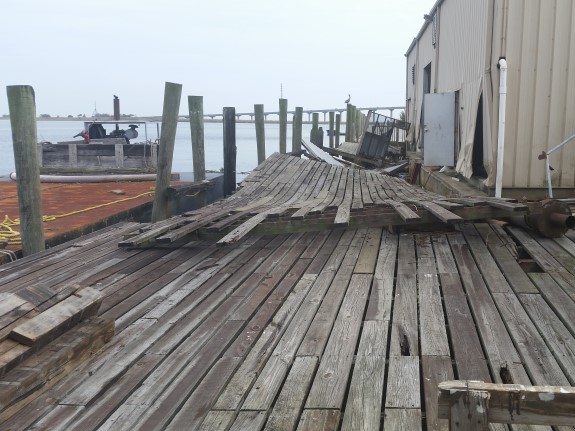It will be a long time before the memories of Hurricane Michael fade in the mind’s eye of many seafood workers in the Mid-Florida Panhandle. Most people have been made aware of how destructive the storm surge was around Mexico Beach, Florida but there were many smaller, less “news-worthy” communities with seafood-based economies that were devastated. This storm was a record-breaking tropical cyclone in many respects. People were caught off guard as it continued to strengthen beyond early predictions during its rapid path through the Northern Gulf of Mexico. It was so big that water levels in areas east-of-center started rising long before it came ashore and stayed up through multiple tidal cycles. Communities that were not even impacted by the massively destructive winds were seeing tides of up to eight feet above normal. When folks went to bed the night before landfall, they had no idea what terrifying news would greet them upon waking; that a still-strengthening, category 4 hurricane was about to rumble ashore.

It was not long after the wind slackened that folks began looking around and realizing the horrible devastation left behind. Even far inland, where most hurricanes would have lost much of their power, people were reeling. Cotton crops in the path of the storm in North Florida and South Georgia suffered near 100% losses. Peanut crops were also severely impacted just at the time that harvest was beginning. The estimated damage to timber harvests alone were coming in around 1.3 billion dollars for Florida as virtually entire forests were leveled. Even more damage was realized near the coastline where storm surge across the region ranged from 8 to 14 feet above normal tidal levels; smashing or flooding homes and businesses to total loss.
The seafood industry was hit hard; everyone from producers to dealers, processors, retail markets, restaurants, charter fishing fleets and critical infrastructure like fueling and ice house facilities that service fishing vessels. Governor Scott requested a fisheries disaster declaration from the Federal Government and on November 1 the Secretary of the Department of Commerce granted it. This determination provides an opportunity for Congress to appropriate fishery disaster assistance. To further facilitate recovery efforts in Florida and beyond, the Department of Commerce can also look to the Economic Development Administration, which spearheads the federal government’s efforts for economic assistance and long-term support after natural disasters.
One specialized segment of the seafood industry that sustained significant losses was the oyster farming community in the region. Most growers had equipment and a growing crop of shellfish in the water. For those who were able to scramble to their growing areas before the storm and sink floating cages to the bay bottoms, losses of gear were minimal. Gear that was unable to be submerged was prone to break loose and drift away. Even growers who did sink gear experienced significant crop losses due to sediments from churned up water that smothered shellfish in silt.
Marinas, docks and vessels were also hard hit, particularly in Gulf and Bay Counties. Government agencies estimate the number of damaged vessels in these two counties alone to exceed 400. It will take some time for charter boat and commercial fishing operations to rebound. Scallop restoration projects in both St. Joseph Bay and St. Andrews Bay have suffered setbacks, as well. The hurricane has not only devastated coastal counties economically and ecologically, but also geographically. There are two new inlets that have been carved through the St. Joseph Peninsula.

The University of Florida Extension faculty in the region began to mobilize as soon as it was safe. Many agents put their personal cleanup and repair tasks on hold as they worked to help others. All Extension program agents were involved with assessing damage and losses for their respective program constituents. Florida Sea Grant Extension agents worked particularly with their seafood industry clientele to gather data that could be rolled up through NOAA for congressional consideration eventually.
The impacts from this storm will be affecting our regional economies for years to come. Lessons learned by industries as well as individuals can improve our chances to reduce the loss of life and property in the future as we better adapt to what Mother Nature sends our way. For people not living in the heavily impacted communities, this may already be a forgotten storm. Believe me though, there are many neighbors still trying to make it…day by day. Hang in there.
 0
0
